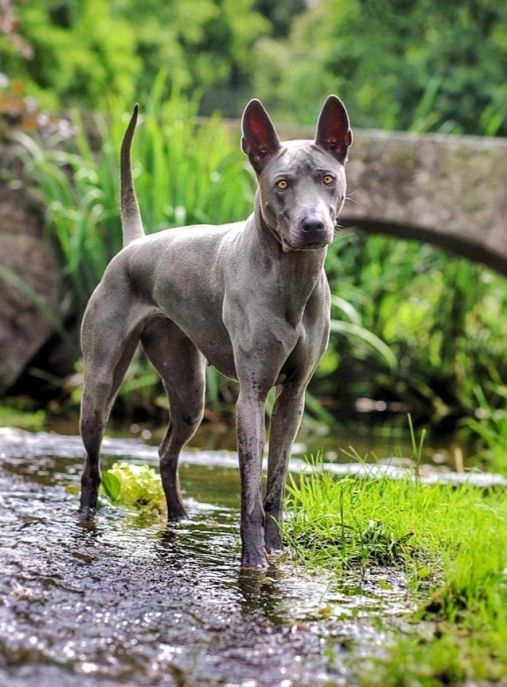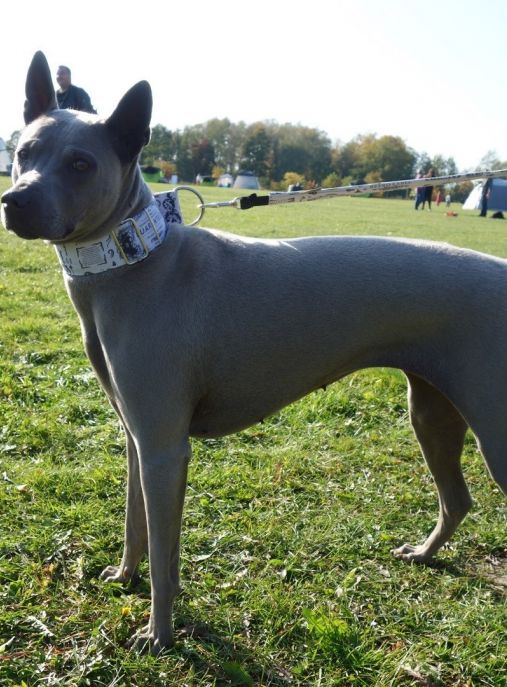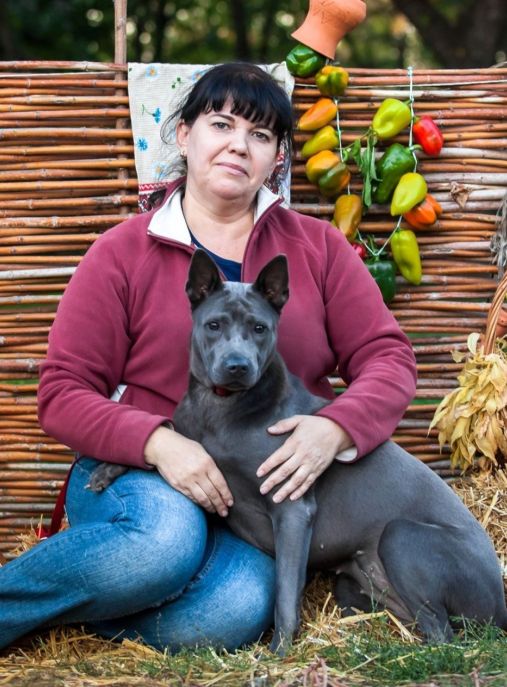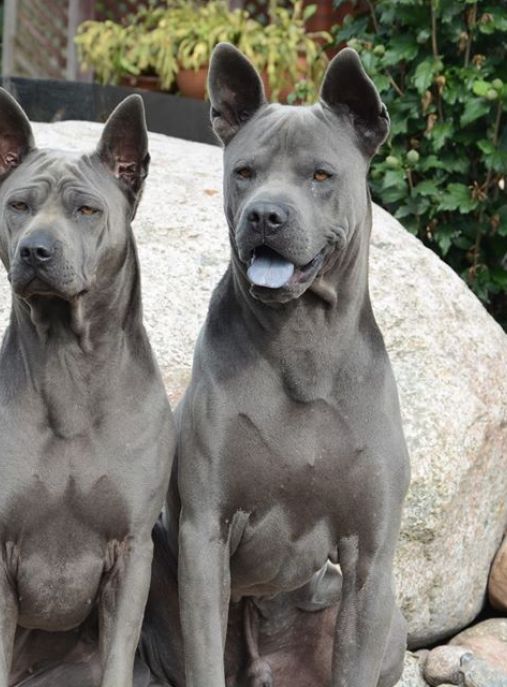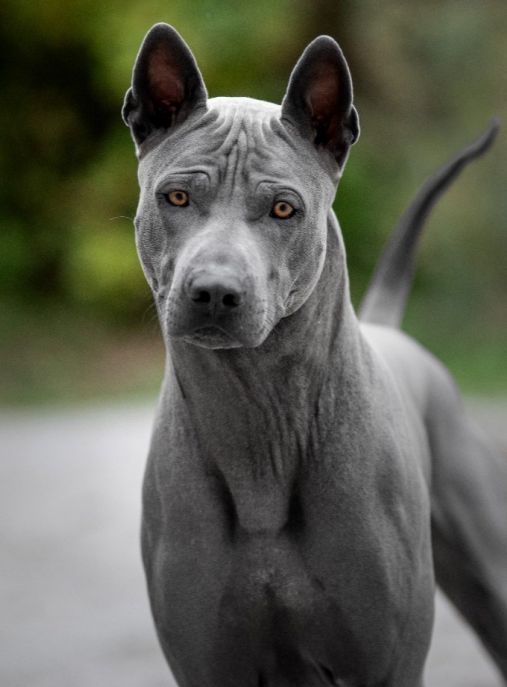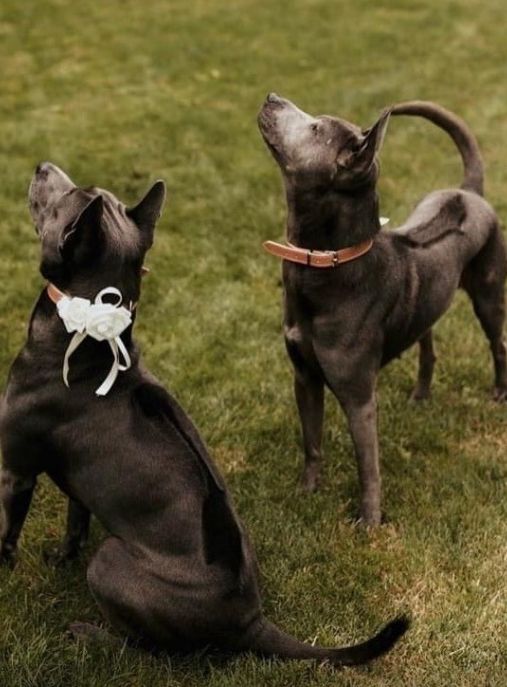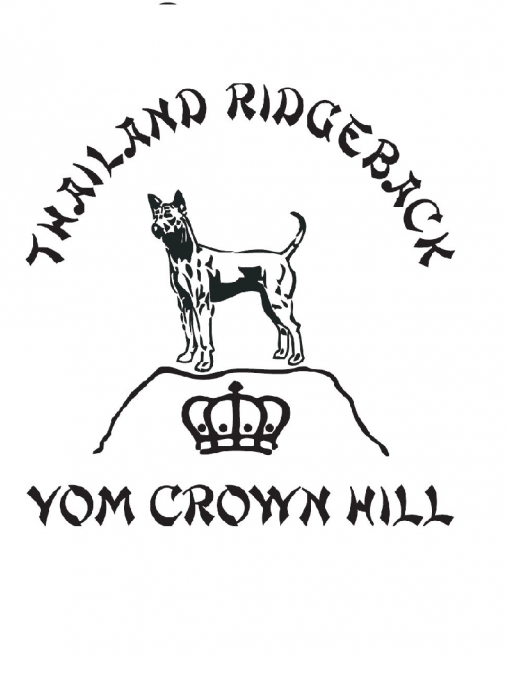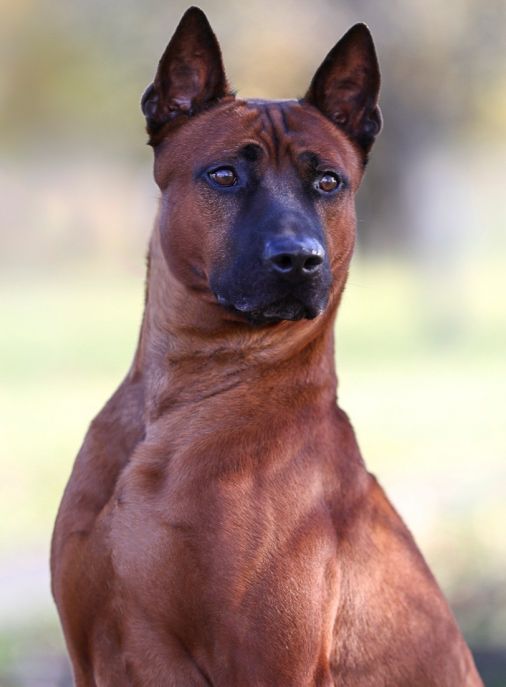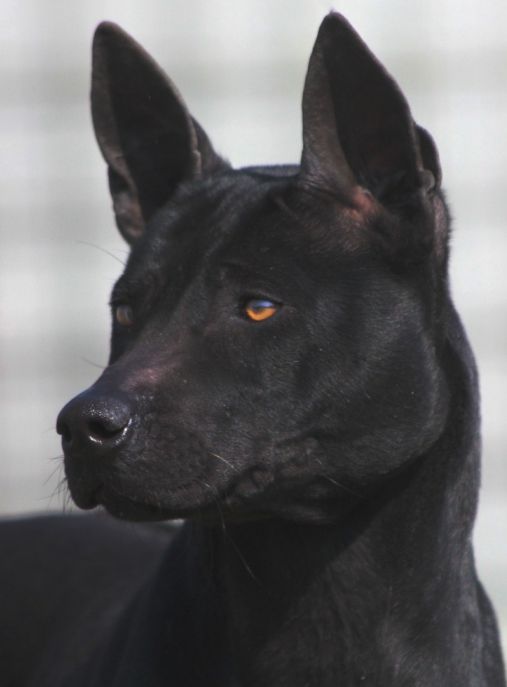The Thai Ridgeback Dog, also known as Mah Thai Lang Ahn, is a unique and ancient breed that hails from Thailand. This medium-sized dog is renowned for its distinctive ridge of hair that runs along its back in the opposite direction to the rest of its coat. With its regal appearance and loyal nature, the Thai Ridgeback Dog has gained popularity not only in its native land but also around the world.
The history of the Thai Ridgeback Dog is shrouded in mystery, as there are no written records of its origin. However, it is believed that this breed has been around for at least 4,000 years, making it one of the oldest known dog breeds. The Thai Ridgeback Dog is thought to have descended from the ancient pariah dogs that roamed Southeast Asia. These dogs were highly adaptable and lived alongside humans, serving as loyal companions and guardians.
According to the FCI (Fédération Cynologique Internationale) typology, the Thai Ridgeback Dog belongs to Group 5: Spitz and Primitive types. This group includes dogs that share common characteristics such as erect ears, a curled tail, and a strong prey drive. The Thai Ridgeback Dog is classified under Section 7: Primitive type - Hunting dogs. This classification highlights the breed's natural hunting instincts and its ability to thrive in challenging environments.
The Thai Ridgeback Dog is known for its versatility and is suitable for various roles. Traditionally, it was used as a hunting dog, assisting in tracking and capturing game. Its agility, endurance, and keen sense of smell made it an invaluable asset to hunters. Additionally, the Thai Ridgeback Dog excels as a guardian, protecting its family and property with unwavering loyalty. Its alertness and protective nature make it an excellent watchdog.
In terms of physical characteristics, the Thai Ridgeback Dog is a medium-sized breed with a well-muscled body. Males typically stand between 22 to 24 inches (56 to 61 cm) at the shoulder, while females are slightly smaller, ranging from 20 to 22 inches (51 to 56 cm). The breed's weight varies between 35 to 55 pounds (16 to 25 kg), with males generally being larger and heavier than females.
One notable feature of the Thai Ridgeback Dog is its distinctive ridge of hair along its back. This ridge consists of hair that grows in the opposite direction to the rest of the coat, creating a unique pattern. The ridge can be seen in three different variations: needle, feather, and violin. The needle ridge is the most desired and is characterized by a straight and narrow ridge. The feather ridge is wider and has a slight curve, while the violin ridge is the widest and has a more pronounced curve.
The Thai Ridgeback Dog has a short and dense coat that comes in various colors, including black, blue, red, and fawn. Some dogs may also have a brindle pattern. The breed's coat is low-maintenance and requires minimal grooming, making it suitable for owners who prefer a dog with minimal shedding.
In terms of temperament, the Thai Ridgeback Dog is known for its loyalty, intelligence, and independence. It forms strong bonds with its family and is protective of its loved ones. Early socialization and training are crucial to ensure that the breed develops into a well-rounded and obedient companion. While the Thai Ridgeback Dog can be aloof with strangers, it is generally good with children and other pets when properly introduced and socialized from a young age.
The average lifespan of the Thai Ridgeback Dog is around 12 to 14 years, which is relatively long for a medium-sized breed. However, like all dogs, they are prone to certain health issues. Some common health concerns in Thai Ridgebacks include hip dysplasia, dermoid sinus (a congenital skin defect), and certain eye conditions. Regular veterinary check-ups, a balanced diet, and regular exercise can help maintain the breed's overall health and well-being.
In conclusion, the Thai Ridgeback Dog is a fascinating and ancient breed that has captivated dog enthusiasts worldwide. With its striking appearance, versatile nature, and unwavering loyalty, it is no wonder that this breed continues to gain popularity. Whether as a hunting companion, a guardian, or a loving family pet, the Thai Ridgeback Dog excels in various roles, making it a cherished and treasured breed.
The Thai Ridgeback Dog is a breed known for its unique appearance and distinctive character. These dogs have a strong and independent nature, making them a fascinating choice for experienced dog owners. In this text, we will delve into the character of Thai Ridgeback Dogs, their behavior, and how to raise and train them effectively.
Thai Ridgeback Dogs are highly intelligent and possess a strong sense of loyalty towards their family. They are known to be reserved and aloof with strangers, making them excellent watchdogs. However, this aloofness can sometimes translate into aggression if not properly socialized from an early age. It is crucial to expose them to various people, animals, and environments to ensure they grow up to be well-rounded and friendly dogs.
These dogs are also incredibly independent and have a strong prey drive. They have a natural instinct to chase small animals, so it is essential to keep them on a leash or in a securely fenced area when outside. Early socialization and obedience training can help control their prey drive and ensure they respond well to commands.
Thai Ridgeback Dogs are known for their high energy levels and require regular exercise to keep them mentally and physically stimulated. Long walks, jogs, or play sessions in a secure area are necessary to prevent boredom and destructive behavior. Providing them with puzzle toys or engaging in activities like agility training can also help keep their minds sharp.
When it comes to raising and training a Thai Ridgeback Dog, consistency and positive reinforcement are key. These dogs respond best to reward-based training methods, such as treats, praise, and play. Harsh training techniques or punishment can lead to fear or aggression, so it is crucial to use gentle and patient methods.
Early socialization is vital for Thai Ridgeback Dogs. Expose them to different people, animals, and environments from a young age to ensure they grow up to be well-adjusted and confident. Enrolling them in puppy classes or obedience training can also help them learn basic commands and improve their social skills.
Thai Ridgeback Dogs are known to be clean and fastidious animals. They have a natural instinct for cleanliness and are relatively easy to housebreak. However, crate training can be beneficial to prevent accidents and provide them with a safe space of their own.
It is important to note that Thai Ridgeback Dogs are not recommended for first-time dog owners or families with young children. Their independent nature and strong-willed character require experienced handling and consistent training. They thrive in homes where they have a clear leader and a structured routine.
In conclusion, Thai Ridgeback Dogs are intelligent, loyal, and independent dogs with a strong prey drive. They require early socialization, consistent training, and regular exercise to ensure they grow up to be well-rounded and well-behaved companions. With the right approach, these dogs can make excellent family pets for experienced owners who can provide them with the guidance and stimulation they need.
The Thai Ridgeback Dog is a unique and ancient breed that requires specific care to ensure their health and well-being. Here are some tips on how to properly care for Thai Ridgeback Dogs, including what to do and what not to do:
1. Exercise: Thai Ridgebacks are an active and energetic breed, so regular exercise is crucial. Aim for at least 30-60 minutes of exercise daily, which can include walks, runs, or playtime in a securely fenced yard. However, avoid excessive exercise in extreme weather conditions to prevent overheating or exhaustion.
2. Grooming: Thai Ridgebacks have a short, dense coat that requires minimal grooming. Brush their coat once a week to remove loose hair and keep their skin healthy. Regularly check their ears for any signs of infection or wax buildup and clean them gently. Trim their nails regularly to prevent overgrowth and discomfort.
3. Nutrition: Provide a well-balanced diet that meets the nutritional needs of Thai Ridgebacks. High-quality dog food with a protein-rich formula is recommended. Avoid overfeeding, as this breed is prone to obesity. Consult with a veterinarian to determine the appropriate portion sizes and feeding schedule for your dog.
4. Training and Socialization: Thai Ridgebacks are intelligent and independent dogs, making early training and socialization crucial. Start training from a young age using positive reinforcement techniques. Socialize them with other dogs, animals, and people to prevent aggression or fearfulness. Enroll them in obedience classes or work with a professional trainer if needed.
5. Mental Stimulation: Thai Ridgebacks are intelligent and need mental stimulation to prevent boredom and destructive behavior. Provide them with interactive toys, puzzle games, and training sessions to keep their minds engaged. Consider activities like agility, obedience, or scent work to challenge their abilities.
6. Health Care: Regular veterinary check-ups are essential to ensure the overall health of your Thai Ridgeback. Vaccinations, parasite prevention, and dental care should be part of their routine. Additionally, be aware of breed-specific health concerns such as hip dysplasia, dermoid sinus, and certain allergies. Regularly inspect their skin for any abnormalities and consult a veterinarian if you notice anything unusual.
7. Avoid Overexposure to Heat: Thai Ridgebacks have a single coat and are sensitive to extreme temperatures. Avoid leaving them outside for extended periods during hot weather, as they can easily overheat. Provide shade, fresh water, and a cool environment to keep them comfortable. Additionally, be cautious of walking them on hot pavement, as it can burn their paw pads.
8. Avoid Harsh Training Methods: Thai Ridgebacks respond best to positive reinforcement training methods. Avoid using harsh or punitive techniques as it can lead to fear or aggression. Instead, use rewards, praise, and consistency to motivate and train them effectively.
9. Secure Fencing: Thai Ridgebacks have a strong prey drive and can be prone to wandering. Ensure your yard is securely fenced to prevent them from escaping. Regularly check for any gaps or weak spots in the fence and address them promptly.
10. Emotional Bonding: Thai Ridgebacks are loyal and affectionate dogs that thrive on human companionship. Spend quality time with them, provide plenty of love and attention, and include them in family activities. Neglect or isolation can lead to behavioral issues or separation anxiety.
Remember, every Thai Ridgeback is unique, and individual care requirements may vary. It's essential to observe your dog's behavior, monitor their health, and consult with a veterinarian for personalized advice. By following these tips, you can provide the best care for your Thai Ridgeback Dog and ensure a happy and healthy life for them.
The Thai Ridgeback Dog is a unique and striking breed known for its regal appearance and distinctive ridge of hair along its back. When it comes to their color, these dogs exhibit a range of shades that add to their allure and charm.
The most common color seen in Thai Ridgeback Dogs is a rich and lustrous solid coat of red. This vibrant hue can vary from a deep mahogany to a lighter, more coppery tone. The red coloration is often uniform throughout the dog's body, including the ridge on its back, giving it a sleek and elegant appearance.
Within the red color spectrum, there can be slight variations in shade and intensity. Some Thai Ridgebacks may have a darker red coat, almost resembling a deep burgundy or chestnut color. Others may have a lighter red coat, reminiscent of a warm sunset or a glowing ember. These variations add depth and character to the breed, making each dog truly unique.
In addition to the red coat, Thai Ridgeback Dogs can also come in other colors, although they are less common. One such color is black, which can range from a solid jet black to a dark charcoal shade. The black coat can create a striking contrast against the dog's almond-shaped eyes and the ridge on its back, making it a captivating sight to behold.
Another less common color seen in Thai Ridgebacks is blue. The blue coat is a dilution of the black color, resulting in a stunning shade that can range from a slate gray to a bluish-silver hue. This color variation is relatively rare and highly sought after by enthusiasts of the breed.
Regardless of the color, Thai Ridgeback Dogs have a short and smooth coat that accentuates their muscular build and athletic physique. This coat is not only visually appealing but also serves as protection against the elements, allowing the dogs to thrive in various climates.
The color of a Thai Ridgeback Dog's coat is just one aspect of its overall appearance, but it plays a significant role in defining the breed's aesthetic appeal. Whether it's the rich red, striking black, or captivating blue, the color of these dogs adds to their allure and makes them stand out in any setting.
The Thai Ridgeback Dog is a unique and ancient breed known for its distinctive ridge of hair running along its back in the opposite direction to the rest of its coat. These dogs are generally healthy and robust, but like any other breed, they can be prone to certain health issues. To ensure the well-being of Thai Ridgeback Dogs, it is important to understand the common diseases they may face and how to care for their overall health.
One of the most common health concerns in Thai Ridgeback Dogs is hip dysplasia. This condition occurs when the hip joint does not develop properly, leading to discomfort, pain, and eventually arthritis. Regular exercise, maintaining a healthy weight, and providing a balanced diet can help reduce the risk of hip dysplasia. Additionally, responsible breeders often perform hip evaluations on their breeding dogs to minimize the occurrence of this condition.
Another health issue that can affect Thai Ridgeback Dogs is hypothyroidism. This condition occurs when the thyroid gland does not produce enough hormones, leading to a range of symptoms such as weight gain, lethargy, and skin problems. Regular veterinary check-ups, including thyroid function tests, can help diagnose and manage hypothyroidism. Treatment typically involves lifelong medication to supplement the deficient hormones.
Thai Ridgeback Dogs may also be prone to certain skin conditions, including allergies and dermatitis. These dogs have sensitive skin, and exposure to allergens such as certain foods, environmental factors, or parasites can trigger allergic reactions. Regular grooming, including bathing with hypoallergenic shampoos, can help maintain healthy skin and minimize the risk of skin issues. It is also important to provide a balanced diet that meets the nutritional needs of the dog and avoids potential allergens.
Like many other breeds, Thai Ridgeback Dogs can also be susceptible to certain eye problems, including progressive retinal atrophy (PRA) and cataracts. PRA is a degenerative condition that leads to gradual vision loss, while cataracts cause clouding of the lens, resulting in impaired vision. Regular eye examinations by a veterinarian can help detect these conditions early on, allowing for appropriate management or treatment options.
To care for the overall health of Thai Ridgeback Dogs, it is essential to provide them with regular exercise to keep them physically fit and mentally stimulated. These dogs have high energy levels and require daily activities such as walks, runs, or play sessions. Mental stimulation through training and interactive toys can also help prevent boredom and destructive behaviors.
Proper nutrition is crucial for the well-being of Thai Ridgeback Dogs. Feeding them a high-quality, balanced diet that meets their specific nutritional needs is essential. Consultation with a veterinarian can help determine the appropriate diet based on the dog's age, activity level, and any specific health concerns.
Regular veterinary check-ups are vital to monitor the overall health of Thai Ridgeback Dogs. Vaccinations, parasite prevention, dental care, and routine blood tests are all important aspects of preventive healthcare. Early detection of any potential health issues can lead to prompt treatment and better outcomes.
In conclusion, while Thai Ridgeback Dogs are generally healthy, they can be prone to certain health conditions such as hip dysplasia, hypothyroidism, skin issues, and eye problems. By providing proper care, including regular exercise, a balanced diet, and routine veterinary check-ups, owners can help ensure the overall health and well-being of these unique and beautiful dogs.
The Thai Ridgeback Dog is a unique and ancient breed known for its intelligence, loyalty, and distinctive ridge of hair along its back. When it comes to their nutrition, it is important to provide them with a well-balanced diet that meets their specific needs. Here is an extensive description of the nutrition of Thai Ridgeback Dogs, along with advice on feeding and what to avoid.
Protein is a crucial component of a Thai Ridgeback Dog's diet. As an active and muscular breed, they require a high-quality source of protein to support their energy levels and maintain lean muscle mass. Good sources of protein for these dogs include lean meats like chicken, turkey, and fish. It is important to ensure that the meat is cooked thoroughly and free from any seasonings or additives that may be harmful to dogs.
In addition to protein, Thai Ridgeback Dogs also require a healthy balance of carbohydrates and fats. Carbohydrates provide them with the necessary energy to fuel their active lifestyle. Opt for complex carbohydrates such as brown rice, sweet potatoes, and whole grains, as they offer more nutritional value compared to simple carbohydrates.
Fats are essential for the overall health of Thai Ridgeback Dogs. They provide a concentrated source of energy and aid in the absorption of fat-soluble vitamins. Incorporate healthy fats into their diet through sources like fish oil, flaxseed oil, and coconut oil. These fats also contribute to a shiny coat and healthy skin.
When it comes to feeding Thai Ridgeback Dogs, it is recommended to divide their daily food intake into two or three meals. This helps prevent bloating and aids in digestion. The exact amount of food required will depend on factors such as age, weight, activity level, and metabolism. It is important to monitor their weight and adjust the portion sizes accordingly to maintain a healthy body condition.
While it is essential to provide a balanced diet, there are certain foods that should be avoided as they can be toxic or harmful to Thai Ridgeback Dogs. Some common foods to avoid include chocolate, caffeine, grapes, raisins, onions, garlic, and foods containing xylitol. These can cause various health issues ranging from gastrointestinal upset to organ damage.
It is also important to avoid feeding Thai Ridgeback Dogs table scraps or excessive treats. While it may be tempting to share your food with them, it can lead to weight gain and nutritional imbalances. Instead, opt for healthy and dog-friendly treats that are specifically formulated for their needs.
Lastly, always ensure that fresh and clean water is readily available for your Thai Ridgeback Dog. Hydration is crucial for their overall health and well-being.
In conclusion, providing a well-balanced and nutritious diet is vital for the health and longevity of Thai Ridgeback Dogs. Focus on high-quality protein sources, complex carbohydrates, and healthy fats. Avoid toxic foods and excessive treats, and always provide access to fresh water. By following these guidelines, you can ensure that your Thai Ridgeback Dog receives the nutrition it needs to thrive.
